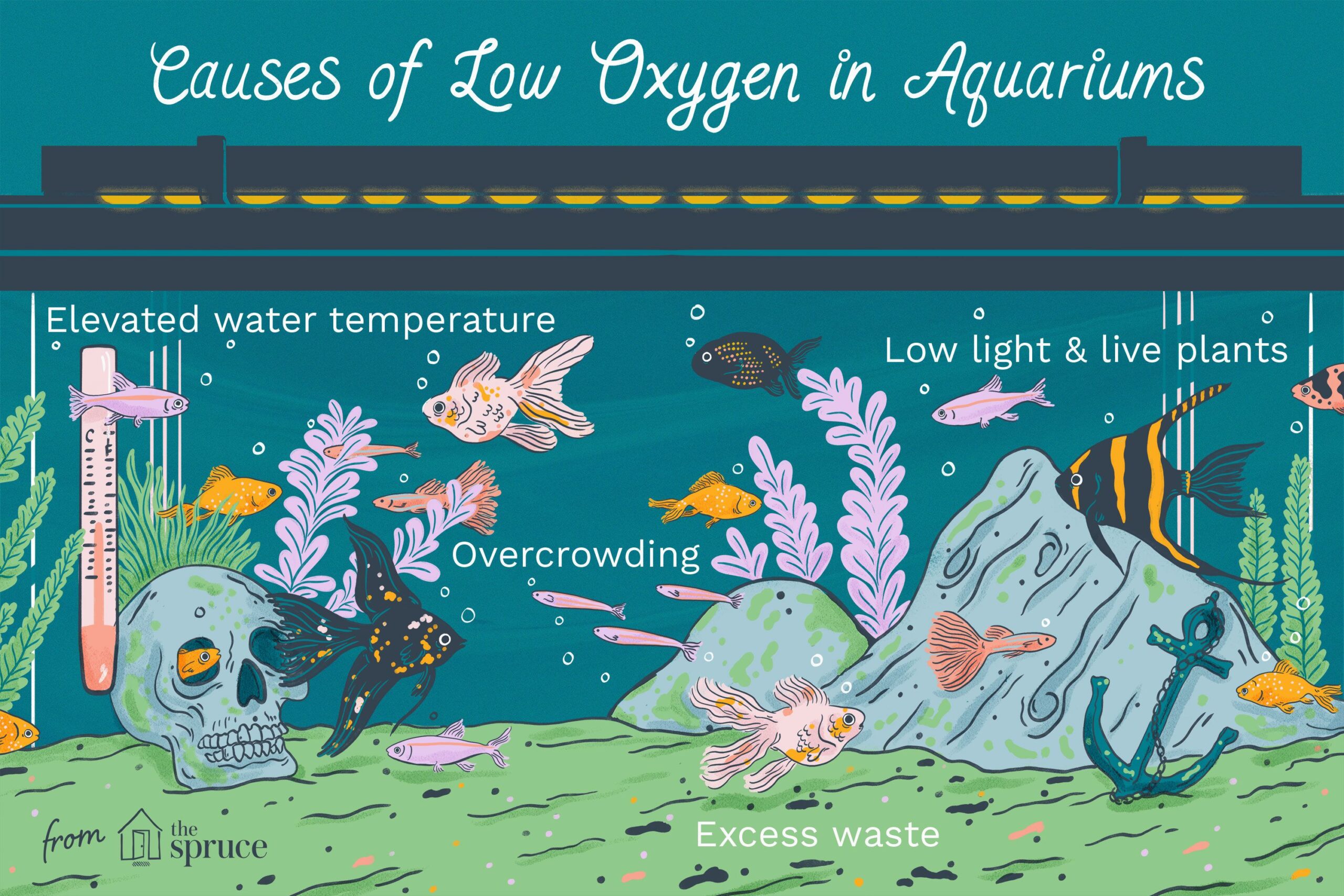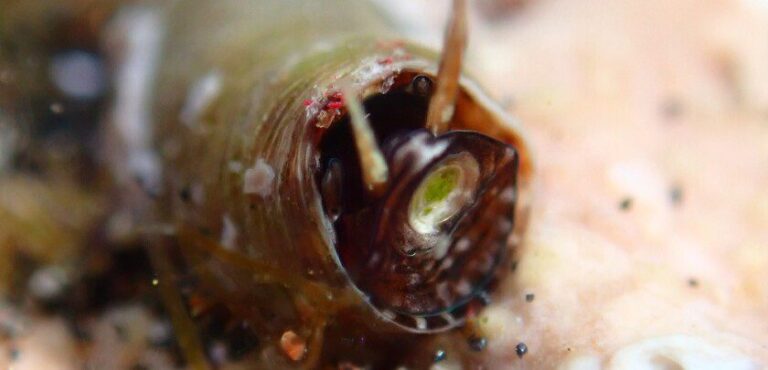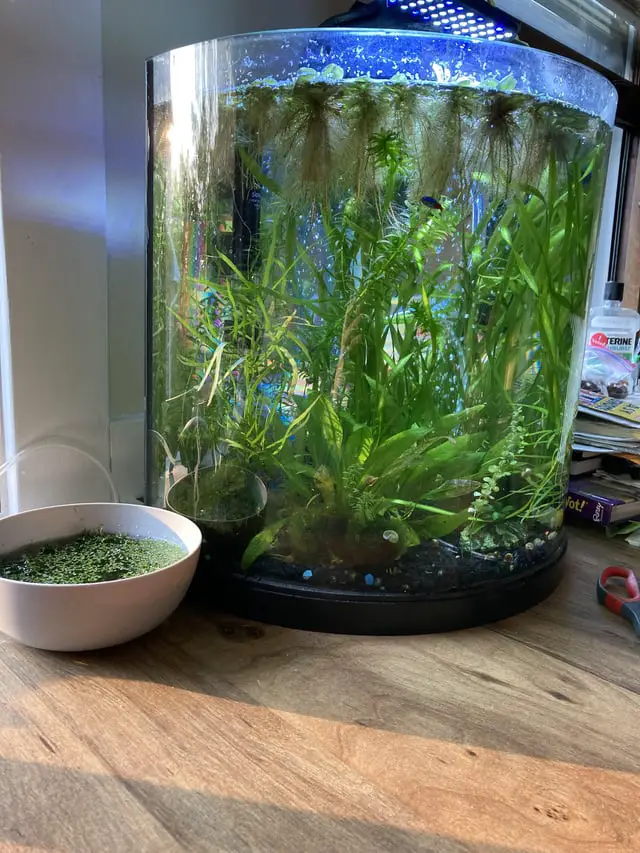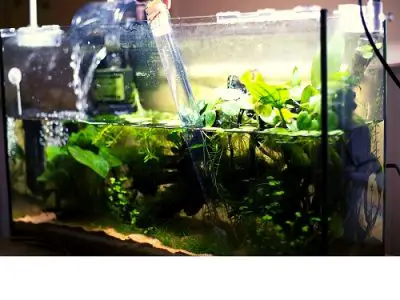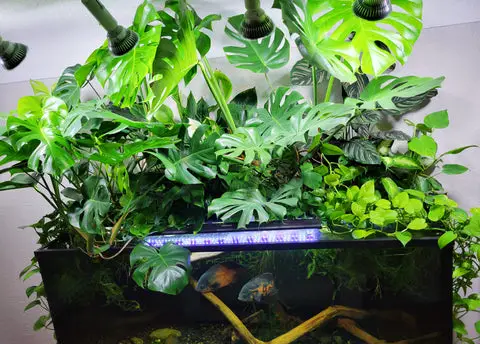How to Increase Oxygen in Fish Tank?
1. Increase the surface area of water exposed to air, this can be done by adding more plants or by increasing the tank size.
2. Install a protein skimmer which will help filter out pollutants and increase oxygen levels in the water.
3. Add an airstone to your fish tank which will release fine bubbles of air into the water that not only add oxygen but also create a pleasing effect in your aquarium.
4. Invest in an aeration pump that can be attached to your fish tank’s hood or lid and adds oxygen directly into the water with a quiet stream of bubbles from its nozzle head.
5. Replace some of your live aquatic plants with plastic ones as they require less oxygen for respiration, leaving more available for other life forms such as fish and invertebrates living in it.
6. Make sure you perform regular maintenance on your aquarium including changing out 10-15% of the old water with fresh dechlorinated tapwater every two weeks to keep things clean and healthy.
7. Finally, make sure you are not overstocking or overcrowding your fish tank as this can lead to low oxygen levels due to excessive waste production from too many animals inhabiting one space.
- Add Aquarium Plants: Adding aquarium plants to your fish tank is one of the best ways to increase oxygen levels in the water. Plants naturally produce oxygen during photosynthesis, and can help maintain healthy levels of dissolved oxygen for your fish. Be sure to choose non-toxic, low maintenance species that will thrive in your specific environment.
- Increase Surface Area: Increasing the surface area in an aquarium increases the amount of contact between air and water which can help boost the level of dissolved oxygen present in a tank’s water column. This can be done by adding decorations such as rocks and driftwood or utilizing different sized tanks with more volume than surface area so there is plenty of room for gas exchange at the water’s surface.
How to Add Oxygen to Fish Tank Fast?
Adding oxygen to a fish tank quickly is important to maintain healthy water parameters and ensure the wellbeing of your aquatic creatures. A good way to add oxygen fast is by using an air pump, which can be easily attached outside the tank and will push aerated bubbles into the aquarium water. You may also consider adding a powerhead or airstone, both of which have been known to help increase oxygen levels in tanks.
Lastly, regular partial water changes are necessary for keeping high levels of dissolved oxygen in your tank over time.
Signs of Low Oxygen in Fish Tank
One sign of low oxygen levels in a fish tank is an increase in surface agitation. Fish will often gasp at the surface of the water and hang around filters or air stones to get more oxygen. Additionally, you may also notice that your fish start swimming erratically, become less active, and have difficulty breathing.
If these signs are present, it’s important to test the oxygen levels in your tank with a dissolved oxygen meter and take measures to raise them if necessary.
How to Put Oxygen in Fish Tank Without Pump?
One way to put oxygen into a fish tank without using a pump is by using an air stone. An air stone works by releasing tiny bubbles of oxygenated water into the aquarium, providing essential oxygen for your fish. To use an air stone, you will need to purchase one and attach it to an airline tubing connected to an air pump.
Make sure the air pump is set up outside of the tank so that no moisture gets inside, as this can damage both the equipment and your fish!
How to Test Oxygen Levels in Fish Tank?
Testing the oxygen levels in your fish tank is an important part of ensuring that your fish are healthy and happy. To do this, you will need to use a handheld electronic device like an Oxygen Meter or dissolved oxygen test kit. These devices measure the concentration of dissolved oxygen in the water, which helps indicate how much oxygen is present for the fish to breathe.
It’s important to regularly check these levels and make sure they remain within normal parameters for optimal tank health.
Oxygen Tablets for Fish Pets at Home
Oxygen tablets are a great way to ensure your fish pets at home have the oxygen they need. These tablets, which dissolve in water, release pure oxygen into the water and provide your fish with an extra boost of oxygen when needed. This can be especially helpful during times of stress or high temperatures, as it helps maintain healthy levels of oxygen for your fish.
Oxygen tablets are easy to use and can be purchased from most pet stores.
Fish Tank Oxygen Pump
Fish tank oxygen pumps are an essential piece of equipment for any fish tank. They provide much-needed oxygen to the water, which helps keep fish healthy and happy. Oxygen pumps also help reduce toxic ammonia levels in aquariums, as well as helping maintain a consistent temperature.
Furthermore, they can be used with other aquarium accessories such as filters and heaters to create a balanced ecosystem in the tank. Ultimately, having an oxygen pump is key to keeping your fish safe and healthy!
Fish Tank Oxygen Tablets
Fish tank oxygen tablets are a convenient way to increase the oxygen levels in your fish tank. They contain hydrogen peroxide and release oxygen when they dissolve into the water, providing additional aeration for your aquarium inhabitants. It’s important to use these tablets responsibly and follow instructions carefully, as too many tablets can be harmful to your fish and other aquatic life.
How to Make Oxygen for Fish at Home?
Making oxygen for your fish tank at home is surprisingly easy! All you need are a few simple materials like a 2-liter bottle, some aquarium air pumps, an airline tubing, and some airstones. Begin by cutting the bottom off of the plastic bottle and drilling holes into it for the airline tubing to fit through.
Connect one end of the tube to an aquarium air pump and place in on one side of the tank. Now attach airstones to both ends of the tube and place them at opposite ends of your tank so that oxygen will be circulated throughout. Once everything is connected, turn on your air pump – now you have a homemade device that will provide much needed oxygen to your fish!

Credit: www.tankarium.com
How Do I Know If My Fish Tank Has Enough Oxygen?
When it comes to the health of your fish, oxygen is a key factor. Ensuring that your tank has enough oxygen can be tricky and there are a few ways to tell if your tank is properly oxygenated.
Firstly, one way you can check if your fish tank has enough oxygen is by looking at the behavior of the fish themselves; healthy and active fish indicate that there’s plenty of oxygen in the water for them to breathe.
Additionally, bubbles on the surface of the water are also a good indication that there’s adequate dissolved oxygen present in your aquarium. A bubbling filter or air stone will help increase aeration further and keep levels high.
Lastly, another way you can check for proper levels of dissolved oxygen in an aquarium is with an electronic device such as a do-it-yourself testing kit or monitor; these devices measure pH, temperature and other parameters including dissolved oxygen which helps determine overall water quality easily and accurately.
Keeping tabs on all these parameters will ensure that you know exactly when changes need to be made so that you can provide optimal conditions for happy and healthy fish!
How Can I Increase Oxygen in My Fish Tank Without a Pump?
Maintaining adequate oxygen levels in your fish tank is essential for the health and wellbeing of your aquatic pets. Unfortunately, not every aquarium setup comes with a pump to increase oxygen in the tank. Fortunately, there are several ways to increase oxygen without an expensive pump.
One great way to add more oxygen is by using plants. Plants will take up carbon dioxide from the water and convert it into usable oxygen through photosynthesis when exposed to light. Another option is adding a bubble stone or airstone which will release tiny bubbles of air into the tank, increasing aeration and allowing more gases like nitrogen, carbon dioxide and other pollutants out of your water while simultaneously adding dissolved oxygen at the same time as well as helping keep pH levels stable by removing harmful toxins from the water column such as ammonia and nitrates.
Additionally, you could also use a powerhead which creates currents that help move around any stagnant areas in your aquarium so that there’s better circulation throughout all areas which increases the amount of fresh air being pulled into those pockets where gas exchange can occur thus further increasing Oxygenation levels within your fish tank’s environment!
How Do You Increase Oxygen in Water?
Adding oxygen to water is a simple process that can be done with some basic equipment. The main way of adding oxygen to water is through aeration, which involves introducing air into the water and allowing it to mix in. This can be done by using a pump or an airstone, both of which are used to create bubbles in the water.
The bubbles created help disperse the oxygen throughout the tank and increase its levels. Another way of increasing oxygen levels in your aquarium is by using an air stone diffuser, which releases tiny particles of air into the tank that then dissolve and become part of the dissolved oxygen content within it. Finally, you may also consider adding aquatic plants such as Elodea or Hornwort to your aquarium as they produce large amounts of Oxygen during photosynthesis and will release this gas back into your fish tank when light intensity decreases at night time – making them ideal for helping keep your fish healthy!
Can Fish Recover from Lack of Oxygen?
Yes, fish can recover from lack of oxygen. Fish use their gills to take in dissolved oxygen from the water and transport it to their organs for respiration. If a fish is deprived of oxygen for an extended period of time, its body will begin to suffer from hypoxia or “lack of oxygen”.
This can cause stress on the fish’s body which may result in weakened immune systems, slowed growth rates and even death if not reversed quickly. Fortunately, there are ways that you can help your fish recover from lack of oxygen. First, you should check your aquarium filter system regularly for any issues that could be reducing the amount of dissolved oxygen in the tank; second, ensure that your tank has adequate circulation with good aeration; thirdly increase surface area by adding live plants or other decorations to allow more contact between air and water molecules; lastly make sure temperatures remain within optimal ranges so as not to further reduce levels of available dissolved oxygen.
By following these guidelines closely you should be able to give your fish a safe return back into healthy waters!
THREE WAYS TO INCREASE OXYGEN LEVEL IN A FISH TANK
Conclusion
Increasing oxygen levels in your fish tank is essential for the health of your aquatic creatures. By following these easy steps, you can easily increase and maintain healthy oxygen levels in your aquarium. Regular water changes, proper aeration, adequate surface area and use of live plants are all effective ways to increase oxygen levels safely and efficiently.
Taking care of the needs of your fish or other aquatic animals should always be a priority – especially when it comes to maintaining optimal water quality!
